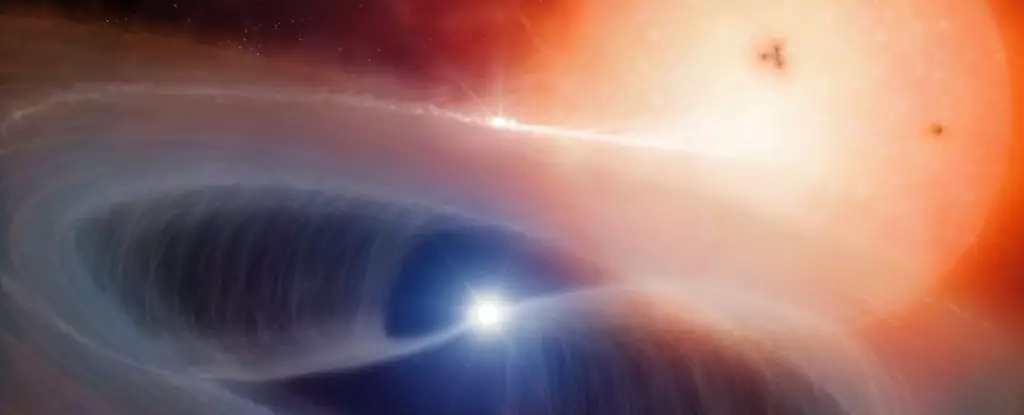The elements that constitute our Universe, particularly the heavier metals, carry with them a tale of cosmic origination that raises profound questions. While it is accepted that these metals are generated in the fierce environments of stellar explosions, the exact processes and stellar progenitors remain enigmatic. Recent studies have shone new light on the origins of Type Ic supernovae—a specific category of these explosive phenomena. Led by a team of astronomers from Poland, this research posits a different narrative than previously believed, highlighting the complex interplay between star mass and binary companionship in the cosmic creation of metals.
Type Ic supernovae are monumental events resulting from the core collapse of massive stars that have exhausted their nuclear fuel. In these supernovae, the absence of hydrogen and helium in the outer shells presents a significant puzzle; stars are expected to retain some of these lighter elements. As these massive stars approach the end of their lifecycles, their cores become increasingly packed with heavier elements, leading to a lack of energy release that ultimately gives way to gravitational collapse. This collapse results in fantastical explosions that not only produce but also disseminate heavier elements across the cosmos.
A long-standing hypothesis regarding Type Ic supernovae revolves around the mass of the progenitor stars. Initially, it was suspected that these astronomical events stemmed from exceptionally massive stars, typically around 20 to 30 solar masses. Such immense stars could potentially expel their lighter elements via intense stellar winds before the supernova detonates, thereby explaining the resultant scarcity of hydrogen and helium. However, the recent findings by the research team suggest that this understanding is overly simplistic and necessitates a paradigm shift.
Through meticulous analysis of archival data and molecular gas remnants at supernova sites, the research team led by astronomers Martín Solar and Michał Michałowski has arrived at a startling conclusion. Rather than solely arising from gigantic stars, many Type Ic progenitors likely originate from less massive stars (approximately 8 to 15 solar masses) that exist in binary systems. These smaller stellar entities share their lifetimes with companion stars, siphoning off lighter elements in a process that precludes their presence in the supernova’s remnants.
The binary relationship proves pivotal, as it allows for significant alterations in the evolution and final explosions of these stars. As Michałowski noted, the understanding of massive stars’ lifecycles is becoming increasingly intricate; the gravitational interactions, chemical compositions, and evolutionary paths are all interlinked in profound ways. If binary partners significantly affect a star’s life span, then they enroll themselves as co-conspirators in cosmic metal generation, inevitably influencing the chemical makeup of the Universe.
The methodology employed in this investigation epitomizes the power of interdisciplinary research—drawing from massive observational programs such as PHANGS, which studies the star formation processes in nearby galaxies. By cross-referencing environments where supernovae have taken place, the researchers could glean insights about the birth characteristics of these stars. Notably, the correlation observed between the molecular gas density and the mass of the progenitor stars offers a fresh perspective on how Type Ic supernovae may contribute to the overall elemental distribution in space.
Furthermore, the revelation that Type Ic supernovae yield significantly higher quantities of carbon deepens our understanding of elemental creation. Carbon, fundamentally significant to life as we know it, owes more of its existence to these explosive events than was previously understood. A continual effort to study supernova remnants could enrich our perceptions and assumptions regarding the life cycles of stars—and by extension, the elemental make-up of the cosmos.
The implications of this research extend well beyond academic curiosity; they resonate through our very understanding of cosmic evolution and the fabric of life itself. The intricate relationship between supernovae and their progenitors invites further exploration into how various stellar environments affect elemental transition. As future studies aim to cast a wider net over more supernovae, astronomers hope to unravel additional layers of mystery surrounding stellar evolution, explosion phenomena, and the role of their binary companions.
The revelations surrounding Type Ic supernovae elevate our comprehension of cosmic chemical enrichment. As we continue to probe deeper into the Universe’s secrets, we must remain open to the complexities that define the life cycles of stars. Our universe, with its tapestry of elements forged in stellar hearts, is a testament to the dynamism of cosmic relationships, revealing a narrative far richer than what initially meets the eye.


Leave a Reply